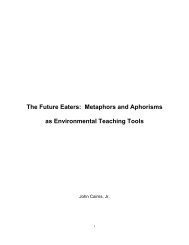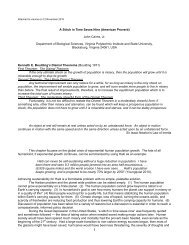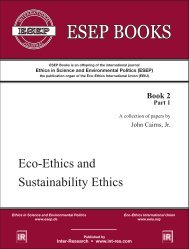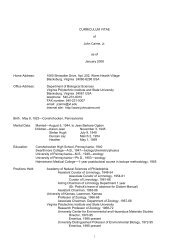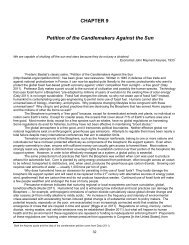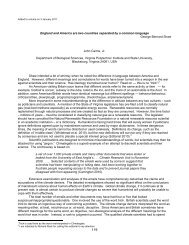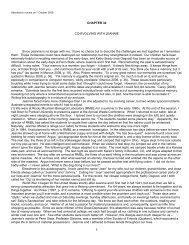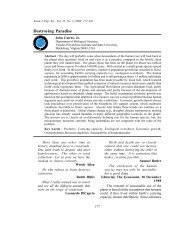View - ResearchGate
View - ResearchGate
View - ResearchGate
Create successful ePaper yourself
Turn your PDF publications into a flip-book with our unique Google optimized e-Paper software.
276Cairns: Eco-Ethics and Sustainability Ethics3. On a finite planet with finite resources, should there be a limit on ecological footprint size?4. How can individuals, corporations, and nations with no conscience be limited in ecologicalfootprint size?5. Should ecological footprint size be regulated for transportation and other energy intensiveactivities?6. The ecological footprint size of India is approximately 0.4 hectares/person. What should the responseof nations with large ecological footprints (e.g. 5.1 hectares/person in the US) be ifIndia’s population continues to grow and the present tenuous carrying capacity is exceeded?7. How should ecological deficits (the level of resource consumption and waste discharge by adefined economy or population in excess of locally/regionally sustainable natural productionand assimilative capacity [Rees 1996]) be eliminated?8. Since resources are finite on a finite planet and humankind is either approaching or has exceededglobal carrying capacity, how can equity and fairness in resource distribution beachieved?9. How can global consensus be reached on whether the goal is maximum number of people(lower quality life) or optimal number of people (higher quality life)?10. What is the equitable and fair distribution of resources between one species (Homo sapiens)and the other 30+ million species with which humans share the planet?11. If humankind overshoots global carrying capacity and causes a major ecological catastropheresulting in decreased carrying capacity, how should this issue be addressed in terms of ecologicalfootprint size?12. Since some nations and cultures will live more sustainably than others because their populationis more stable and more concerned about the size of their ecological footprint, what shouldthey do when environmental refugees attempt to move into their ecosystem? Additionally, howwill these comparatively prosperous, attractive countries avoid threats of resource wars andterrorism?Excessive faith in technology and economics has fostered a belief that the planet’s carryingcapacity for humans is infinitely expandable. If this belief were true, the ecological footprint sizewould be a matter of academic interest, rather than a valuable concept for understanding sustainableuse of the planet. However, the human population is still growing, as are expectations of morematerial goods per capita. Earth’s resource base is simply not keeping up with expectations, andthe present level of affluence is only possible because natural capital is being consumed at agreater than replacement rate. Even if the new technology does increase the resource base, thehuman population will expand to utilize the newly available resources, thus ensuring only a temporaryincrease in resources per capita.In addition, new technologies may have undesirable side effects. For example, genetically modifiedpotatoes may be able to immunize humans against hepatitis B and cholera, but uncertaintyexists about the containment of the modified genes. In March 2004, voters in Mendocino County,California, US attempted to ban the propagation, cultivation, raising, and growing of geneticallymodified organisms. Whatever the outcome of this battle between concerned citizens and thebiotechnological industry, this battle will probably be fought globally for many years to come.Whatever the outcome, a long-term increase of resources per capita is doubtful.The twenty-first century represents a defining moment for humankind. This globally dangerousperiod of human history has two major threats: (1) overshooting global carrying capacity forhumans and (2) major damage to Earth’s ecological life support system as well as natural capital



